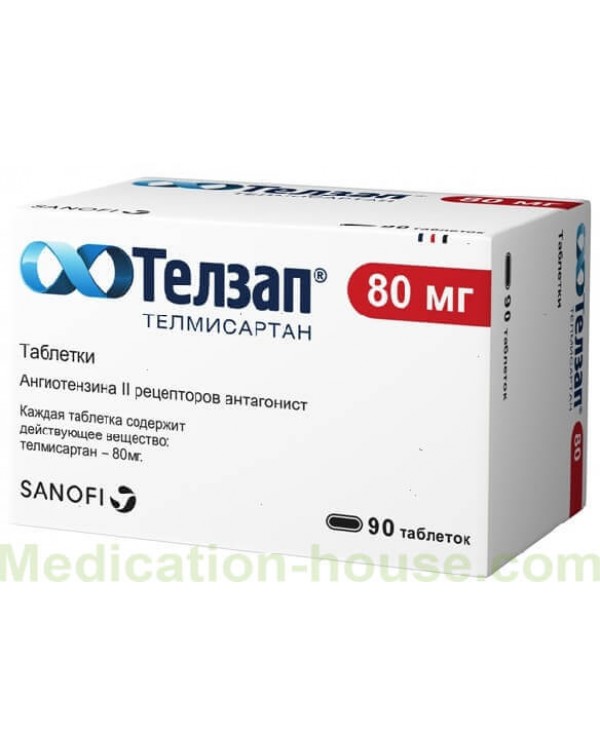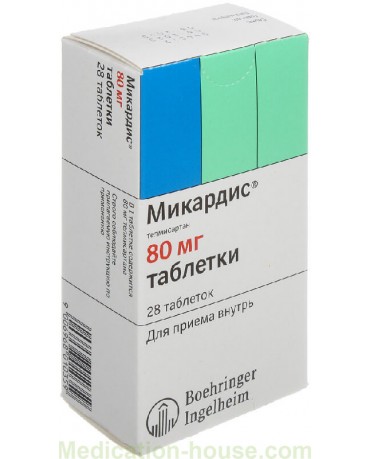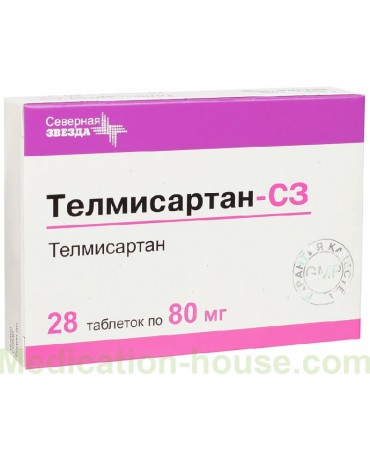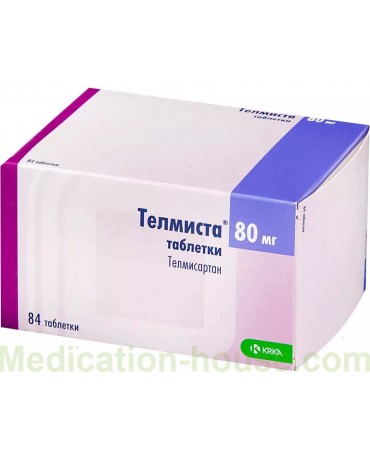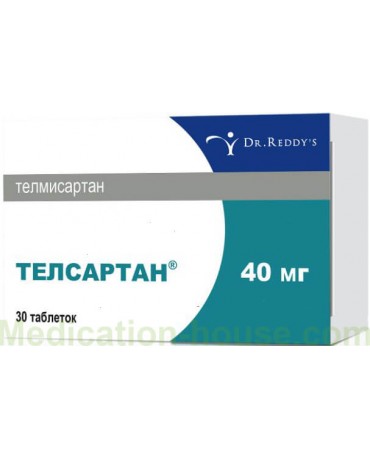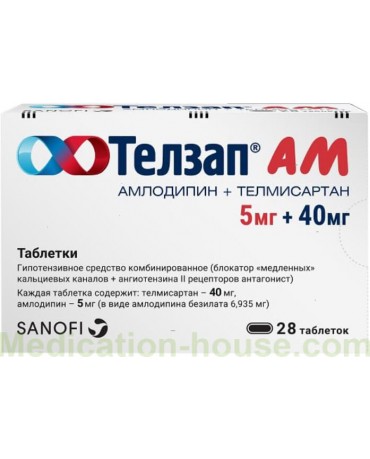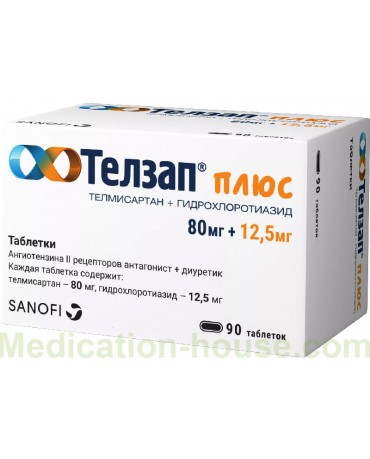Instruction for Telzap
Reed more and buy Telzap on this page
Telzap is an antihypertensive drug, angiotensin II receptor blocker.
Release form and composition
The drug is available in the form of film-coated tablets: from yellowish to almost white, oblong, biconvex; 40 mg - with a dividing line on each side, 80 mg - engraved "80" on one side (10 pcs. in blisters, in a cardboard box of 3, 6 or 9 blisters and instructions for using Telzap).
1 tablet contains:
active substance: telmisartan - 40 mg or 80 mg;
auxiliary components: povidone 25, meglumine, sodium hydroxide, sorbitol, magnesium stearate.
Pharmacodynamics
Telzap is an antihypertensive drug, its active ingredient is telmisartan, a specific antagonist of angiotensin II receptors (AT1 subtype). Telmisartan has a high degree of affinity for AT1 (angiotensin) receptors, through which the action of angiotensin II is realized. Lacking the action of an agonist on the receptor, because of its connection with it, it displaces angiotensin II and binds only to the subtype of AT1-receptors of angiotensin II. Telmisartan has no affinity for other angiotensin receptors (including AT2 receptors). Their functional significance and the effect of possible overstimulation with angiotensin II have not been studied. Telmisartan reduces the level of aldosterone in the blood plasma, does not block ion channels, does not reduce the activity of renin, does not inhibit the action of the angiotensin-converting enzyme (kininase II), which catalyzes the destruction of bradykinin. This avoids the development of dry cough and other side effects due to the action of bradykinin.
With essential hypertension, taking Telzap at a dose of 80 mg blocks the hypertensive effect of angiotensin II. The hypotensive effect after the first dose of telmisartan occurs within 3 hours and lasts for 24 hours, remaining clinically significant for up to 48 hours. A pronounced antihypertensive effect is achieved after 28–56 days of regular administration of the drug.
In hypertension, telmisartan reduces systolic and diastolic blood pressure (BP) without affecting the heart rate (HR).
Abrupt withdrawal of Telzap is not accompanied by the development of withdrawal syndrome, blood pressure gradually returns to baseline values over several days.
The antihypertensive effect of telmisartan is comparable to the action of antihypertensive drugs such as amlodipine, enalapril, hydrochlorothiazide, atenolol and lisinopril, but with the use of telmisartan there is a lower likelihood of dry cough, in contrast to angiotensin-converting enzyme (ACE) inhibitors.
The use of telmisartan for the prevention of cardiovascular diseases in adult patients (age 55 and older) with transient ischemic attack, coronary heart disease, peripheral arterial disease, stroke or complications of type 2 diabetes mellitus (including retinopathy, left ventricular hypertrophy, macro- or microalbuminuria) in history contributed to a decrease in the combined endpoint: hospitalization for chronic heart failure, cardiovascular mortality, myocardial infarction or stroke without fatal outcome. Telmisartan has a similar effect to ramipril in reducing the frequency of secondary points: cardiovascular mortality, myocardial infarction or stroke without fatal outcome. Unlike ramipril, while taking telmisartan, the incidence of dry cough and angioedema is lower, and arterial hypotension is higher.
Pharmacokinetics
After oral administration, the absorption of telmisartan from the gastrointestinal tract occurs quickly, its bioavailability is 50%. Simultaneous food intake causes a decrease in AUC (total plasma concentration), but within three hours the concentration of telmisartan in blood plasma levels off.
Compared to men, in women, Cmax (maximum concentration in blood plasma) is 3 times higher, and AUC is about 2 times higher, but this does not significantly affect the effectiveness of Telzap.
There is no linear relationship between dose and plasma concentration of the drug. When using daily doses above 40 mg, Cmax and AUC change disproportionately to the dose increase.
Plasma protein binding (mainly albumin and alpha1-acid glycoprotein) - more than 99.5%.
The average apparent volume of distribution is 500 liters.
Telmisartan metabolism occurs by conjugation with glucuronic acid, the conjugate has no pharmacological activity.
T1 / 2 (half-life) - more than 20 hours. It is excreted unchanged mainly (99%) through the intestines, less than 1% is excreted by the kidneys.
Total plasma clearance is about 1000 ml / min, hepatic blood flow is up to 1500 ml / min.
With mild to moderate impairment of renal function, as well as in patients over the age of 65, the pharmacokinetics of telmisartan is not impaired, therefore, dose adjustment is not required.
In severe renal failure and for patients on hemodialysis, the initial dose should not exceed 20 mg per day.
Telmisartan is not excreted by hemodialysis.
For mild to moderate liver dysfunction (classes A and B according to the Child-Pugh classification), a daily dose of up to 40 mg should be used.
Indications for use
essential hypertension;
a decrease in the incidence of cardiovascular diseases and mortality in adult patients with diseases of the cardiovascular system of atherothrombotic etiology (ischemic heart disease, damage to peripheral arteries or a history of stroke) and with damage to target organs in type 2 diabetes mellitus.
Contraindications
severe liver dysfunction (Child-Pugh class C);
obstructive diseases of the biliary tract, cholestasis;
simultaneous use of aliskiren in severe renal impairment [GFR (glomerular filtration rate) less than 60 ml / min / 1.73 m2 of body surface] or in case of diabetes mellitus;
concomitant therapy with angiotensin-converting enzyme (ACE) inhibitors in patients with diabetic nephropathy;
hereditary fructose intolerance;
period of pregnancy;
breast-feeding;
age under 18;
hypersensitivity to the components of the drug.
Telzap should be used with caution in severe chronic heart failure, hypertrophic obstructive cardiomyopathy, stenosis of the aortic and mitral valves, impaired renal function, bilateral renal artery stenosis, artery stenosis of the only functioning kidney, mild to moderate liver dysfunction, decreased circulating blood volume (BCC ) against the background of limited consumption of table salt, diarrhea, vomiting or taking diuretics, hyperkalemia, hyponatremia, primary hyperaldosteronism, in the period after kidney transplantation, use in patients of the Negroid race.
Instructions for use: method and dosage
Telzap tablets are taken orally with a sufficient amount of liquid, regardless of the meal.
The frequency of taking the drug is 1 time per day.
Recommended daily dosage:
arterial hypertension: the initial dose is 20-40 mg. In the absence of a sufficient hypotensive effect after 28–56 days of therapy, the initial dose can be increased. The maximum daily dose is 80 mg. As an alternative, a combination of Telzap with thiazide diuretics (including hydrochlorothiazide) is indicated;
reduction in mortality and the incidence of cardiovascular diseases: 80 mg, at the beginning of treatment, it is necessary to control the level of blood pressure. If necessary, correction of antihypertensive therapy should be carried out.
In severe renal failure or patients on hemodialysis, it is recommended to use an initial daily dose of no more than 20 mg.
With mild to moderate renal impairment, dose adjustment is not required.
With mild to moderate hepatic impairment (classes A and B according to the Child-Pugh classification), the daily dose of Telzap should not exceed 40 mg.
Side effects
general disorders: infrequently - asthenia, chest pain; rarely - flu-like syndrome;
diseases of infectious and parasitic genesis: infrequently - urinary tract infections (including cystitis), upper respiratory tract infections (including sinusitis, pharyngitis); rarely - sepsis (including death);
on the part of the cardiovascular system: infrequently - bradycardia, orthostatic hypotension, marked lowering of blood pressure; rarely - tachycardia;
from the lymphatic system and blood: infrequently - anemia; rarely - thrombocytopenia, eosinophilia;
from the immune system: rarely - hypersensitivity reactions, anaphylactic reactions;
on the part of the psyche: infrequently - depression, insomnia; rarely - anxiety;
from the side of metabolism and nutrition: infrequently - hyperkalemia; rarely - hypoglycemia against the background of diabetes mellitus;
from the gastrointestinal tract: infrequently - abdominal pain, vomiting, dyspepsia, flatulence, diarrhea; rarely - dry mouth, impaired taste, discomfort in the stomach;
from the hepatobiliary system: rarely - liver damage, liver functional disorders;
from the nervous system: infrequently - fainting; rarely - drowsiness;
on the part of the organ of hearing, labyrinth disorders: infrequently - vertigo;
on the part of the organ of vision: visual disturbances;
from the respiratory system, chest and mediastinal organs: infrequently - cough, shortness of breath; very rarely - interstitial lung disease;
dermatological reactions: infrequently - itching, skin rash, hyperhidrosis; rarely - drug rash, urticaria, erythema, eczema, toxic skin rash, angioedema (including fatal);
from the urinary system: infrequently - impaired renal function, acute renal failure;
from the musculoskeletal system and connective tissue: infrequently - muscle spasms, back pain (sciatica), myalgia; rarely - pain in the extremities, arthralgia, pain in the tendons (tendinitis-like syndrome);
laboratory indicators: infrequently - an increase in the level of creatinine in the blood plasma; rarely - a decrease in the content of hemoglobin in the blood plasma, an increase in the activity of liver enzymes and creatine phosphokinase, an increase in the concentration of uric acid in the blood plasma.
Overdose
Symptoms: marked decrease in blood pressure, tachycardia, dizziness, bradycardia, increased serum creatinine concentration, acute renal failure.
Treatment: immediate gastric lavage, artificial vomiting, intake of activated charcoal. The severity of symptoms and the patient's condition should be carefully monitored. Prescribe symptomatic and supportive therapy. It is important to ensure that the blood is monitored regularly for electrolytes and plasma creatinine. With a pronounced decrease in blood pressure, the patient should be placed with his legs raised. Carry out activities to replenish the BCC and electrolytes.
The use of hemodialysis is impractical.
Special instructions
When prescribing Telzap to patients with bilateral renal artery stenosis or stenosis of an artery of a single functioning kidney, it should be borne in mind that taking the drug may increase the risk of severe arterial hypotension and renal failure.
Treatment with the drug should be started only after elimination of the existing deficiency of the BCC and / or sodium content in the blood plasma.
The use of Telzap in patients with impaired renal function is recommended to be accompanied by periodic monitoring of the content of potassium and creatinine in the blood plasma.
Inhibition of the RAAS (renin-aldosterone-angiotensin system) can occur in predisposed patients and while taking telmisartan with other RAAS antagonists. It can cause hypotension, fainting, hyperkalemia, and impaired renal function (including acute renal failure).
In chronic heart failure, kidney disease or other pathologies with a predominant dependence on the activity of the RAAS, the appointment of Telzap can cause the development of acute arterial hypotension, hyperazotemia, oliguria, in rare cases - acute renal failure.
With primary hyperaldosteronism, the use of the drug is ineffective.
During treatment with telmisartan, patients with diabetes mellitus receiving insulin or oral hypoglycemic agents may experience hypoglycemia, therefore, careful monitoring of blood glucose levels is required. If necessary, the dose of insulin or hypoglycemic agent should be adjusted.
It should be taken into account and special care should be taken when prescribing Telzap to patients with concomitant diseases such as renal failure, diabetes mellitus, patients on simultaneous therapy with drugs that cause an increase in plasma potassium levels, elderly patients (over 70 years old), since these categories of patients are at high risk of developing hyperkalemia, including fatal ones.
During the period of drug treatment, the simultaneous administration of other drugs should be performed only as directed by the attending physician.
An excessive decrease in blood pressure in ischemic cardiomyopathy or coronary heart disease can lead to the development of myocardial infarction or stroke.
In patients of the black race, a less effective lowering of blood pressure is noted.
Influence on the ability to drive vehicles and complex mechanisms
During the period of taking Telzap, it is recommended to be careful when driving vehicles and mechanisms due to the possibility of dizziness and drowsiness.
Application during pregnancy and lactation
The use of Telzap tablets during gestation and breastfeeding is contraindicated.
Patients taking Telzap, after establishing the fact of conception, should immediately stop therapy with telmisartan and switch to treatment with an alternative antihypertensive drug with an established safety profile of use during pregnancy and lactation.
Childhood use
Due to the lack of information on the safety and efficacy of Telzap in childhood and adolescence, prescribing the drug to patients under 18 years of age is contraindicated.
With impaired renal function
The appointment of Telzap is contraindicated in patients with renal insufficiency (GFR less than 60 ml / min / 1.73 m2) who are on concomitant therapy with aliskiren.
With caution, Telzap should be prescribed for impaired renal function, bilateral renal artery stenosis, artery stenosis of the only functioning kidney.
In severe renal failure and patients on hemodialysis, it is recommended to use an initial daily dose of no more than 20 mg.
With mild to moderate renal impairment, dose adjustment is not required.
For violations of liver function
The appointment of Telzap is contraindicated for the treatment of patients with severe hepatic insufficiency (class C according to the Child-Pugh classification).
With caution, tablets should be taken with mild to moderate hepatic impairment (classes A and B according to the Child-Pugh classification). The daily dose of telmisartan should not exceed 40 mg.
Use in the elderly
No dose adjustment is required for elderly patients.
Drug interactions
With the simultaneous use of Telzap:
aliskiren: in patients with renal failure or diabetes mellitus, combination therapy with telmisartan and aliskiren leads to a double blockade of the RAAS, as a result of which the frequency of adverse events in the form of arterial hypotension, hyperkalemia and renal dysfunction increases;
ACE inhibitors: in patients with diabetic nephropathy against the background of concomitant therapy with ACE inhibitors, a double blockade of the RAAS occurs, therefore the combination of telmisartan and ACE inhibitors is contraindicated;
potassium-sparing diuretics (including spironolactone, eplerenone, amiloride, triamterene), potassium-containing dietary supplements, potassium-containing salt substitutes, nonsteroidal anti-inflammatory drugs (NSAIDs), heparin, cyclosporin, tacrolimus, trimethoprim: increase the likelihood of hyperkalemia. If necessary, joint use should regularly monitor the level of potassium concentration in the blood plasma;
digoxin: there is an increase in the average concentration of digoxin in the blood plasma (Cmax - by 49%, Cmin - by 20%), therefore, when choosing a dose of telmisartan or stopping its administration, the level of digoxin in the blood plasma should be monitored, avoiding exceeding the limits of its therapeutic range;
lithium preparations: it should be borne in mind that against the background of combination therapy with angiotensin II receptor antagonists and ACE inhibitors, the concentration of lithium in the blood plasma may increase to the level of its toxic effect;
non-selective NSAIDs, acetylsalicylic acid (doses used for anti-inflammatory treatment), cyclooxygenase-2 (COX-2) inhibitors: help to weaken the hypotensive effect of telmisartan. In case of impaired renal function, the combination with COX-2 inhibitors can cause a reversible deterioration in renal function;
diuretics: previous therapy with high doses of thiazide and loop diuretics increases the risk of hypovolemia and arterial hypotension at the beginning of telmisartan treatment;
other antihypertensive drugs: enhance the effect of telmisartan;
antidepressants, ethanol, barbiturates, narcotic drugs: increase the risk of orthostatic hypotension;
corticosteroids for systemic use: cause a weakening of the hypotensive effect of Telzap.
Terms and conditions of storage
Keep out of the reach of children.
Store at temperatures up to 25 ° C.
Shelf life is 2 years.
Reviews
The few reviews about Telzap are positive. Patients indicate that taking the drug with arterial hypertension allows you to effectively control blood pressure.
Terms of sell
You can buy Telzap without a prescription.

